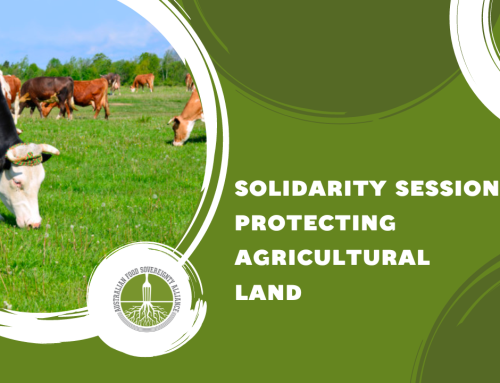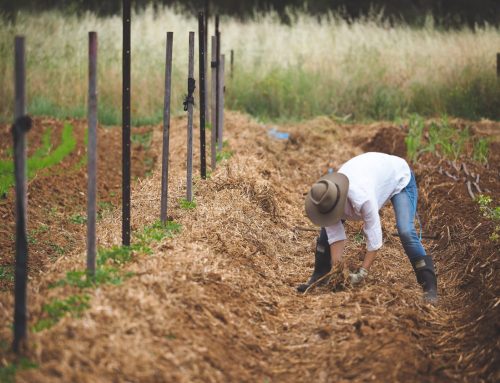IT RAINED. According to native Hobartians at the sixth national gathering of the Australian City Farms & Community Gardens Network in Tasmania, the gathering, and those attendees from mainland Australia, brought with them the first rains in four months. A rainless gap that long is unusual in this state.
The change of weather also brought what, for mainlanders, was a noticeable drop in temperature. Those coming in from the summery eastern states dressed in T-shirts were soon digging in their bags for their warm clothes.
Contexting community gardening

From left: Nick Rose, Kirsten Larsen, Peta Christensen, Sandra Murray, Chris Ennis, Costa Georgiadis
Maybe, thought the organisers of Food4Thought, the name given the gathering, it is time to context the practice of community gardening within the broader practice of civic agriculture, community and small business/social enterprise food systems in Australia. So it was that the decision was made to invite a speaker from the Australian Food Sovereignty Alliance, CERES sustainability education centre in Melbourne, Cultivating Community and Eaterprises, another Melbourne initiative, to provide that big picture image.
Eaterprises, led by Kirsten Larsen — who was associated with Melbourne University’s Victorian Eco Innovation Lab that produced Food Sensitive Planning & Urban Design, a publication that outlined how food production could be incorporated as a normal practice in our cities — is engaged around food with communities on the Melbourne fringe. Kirsten described this innovative project that could provide a prototype for future programs linking communities with the food they eat. She is also associated with the Open Food Foundation, which is producing free, open source software for operating food hubs.
CERES provides training in its market garden located adjacent to the centre in Brunswick, a Melbourne suburb. It operates a weekly organic food market and a community supported agriculture scheme called CERES Fair Food that delivers weekly organic food boxes to subscribers. The scheme works much like Sydney’s Ooooby and Brisbane’s Food Connect.
Cultivating Community is a community NGO contracted to the Victorian government to provide community gardening and community food systems support to residents in social housing. Their small staff assists with more than a dozen community gardens and has had involvement in school food gardens, food co-operatives and community kitchens. Some years ago, Cultivating Community prototyped a model of school gardening and cooking with chef, Stephanie Alexander. Peta Christensen outlined the work of Cultivating Community.
The Australian Food Sovereignty Alliance’s Nick Rose linked community gardening with the idea of food sovereignty, of people being able to exercise free choice over their food supply in regard to how and where it is produced, processed and distributed. Nick linked food choices to the struggle of Australia’s declining number of smaller farmers supplying the domestic market to earn a decent income, and to the threat posed to them by the import and potential dumping of foods produced overseas on the Australian market thanks to international trade agreements.
The conference
Food4Thought sold out, at 160 attendees the hall at Hobart’s Ogilvie High School reached its carrying capacity. Significantly, all states and territories were represented at the gathering, signifying how community gardening has spread nationwide these past 15 years.
Workshops covered a wide range, from how-to topics through to an open space workshop on developing Local Food Acts in the states. One of the workshops brought together local government staff.
Tours took participants out into Hobart’s chilly rain (the weather improved through the weekend of the gathering and the sun actually reappeared) to community and home gardens.
One of the tours journeyed south, first to the Taroona Neighbourhood Garden on Hobart’s southern suburban edge where local food advocate, Nel smit, is a member. It’s a large, impressive community garden replete with a variety of fruit trees, some espaliered along the fence, and its vegetable and herb beds. Then it was along the winding road over low, forested hills to travel beside the grey waters of the D’entrecasteaux Channel to the town of Snug with its impressive primary school food garden and apple variety collection, then down to the village of Woodbridge to see the food garden at the local high school and meet people from the village’s community supported agriculture scheme.
Grown-up
As a social practice and as a largely uncoordinated social movement, community gardening has grown up. Since its modest start at Nunawading, Melbourne, in 1977, the practice went through its gestation, then childhood and, in the 1990s, it entered its adolescence, a time of experimentation to find our what worked where and why, and what didn’t. In that decade, the practice started a slowly-accelerating period of growth that would culminate as a valid urban landuse in the following decade.
The fist decade of the current century saw local government and, in some places, state government interest in community gardening as a social and health promotion initiative, and it’s then that professional community workers became involved. In the second half of that decade forward-thinking local government started to develop policy and other means of assisting community gardens make a start on public land. At the same time, old media interest — newspapers, magazines, TV and radio — grew and community gardening started to appear increasingly on new, social media.
At a community garden conference at Canberra University in 2010, Myles Bremner, then with the London 2012 new gardens by 2012 program, and Australian Greens politician, Christine Milne, said that the Australian City Farms & Community Gardens Network would sooner or later need to develop an advocacy capacity, such was the growth of community gardening and local government interest in it.
Both said that getting some idea of the number of community gardens and community gardeners would be a necessity as politicians, when approached, count heads. Out of that suggestion came the Australian City Farms & Community Gardens Network’s community garden mapping program, which is currently underway and on which community gardens are invited to register so as we have the numbers to give us a voice in civic agriculture and related urban affairs, and so we can defend ourselves against attacks on the practice of community gardening such as those of the industry body Ausveg, earlier this year.
Food4Thought demonstrated that community gardening, and the closely-associated practice of food gardening in schools, has come of age in Australia. That a conference in a state distant for many could attract 160 participants, including those form local government, schools and other institutions, demonstrates how far the practice has come.
Years ago, not all that long after Darren Phillips set up the Australian City Farms & Community Gardens Network to link community gardeners and others in 1995, the Network set a goal of establishing community gardening as a valid urban landuse. We did that by talking with and often advising council staff — something we continue to do — and by educating and linking gardeners so that they could share what they learn.
Now, with the emergence of food sovereignty onto Australia’s social and political agenda, we have started to make the link between community gardening and the wider community food movement, sometimes called the ‘fair’ or ‘local’ food movement, a movement that is broad enough to include not only community and school food gardens, but farmers, social enterprise food systems like community supported agriculture and food co-ops and small to medium size food business.
As part of this larger nexus around fair food, food that treats farmers, food processors and eaters fairly regarding price, quality and in putting our own food sovereignty and food security interests as Australians first, community gardening continues to provide its traditional access to fresh food, social contact and social learning in our towns and cities.
Food4Thought was another step in this direction.
View Storehouse photo essay on Food4Thought — follow the link below
Some useful websites
[button_link url=”https://www.communitygarden.org.au” target=”blank” background=”#98CC66″ style=”” title=”” class=”icon-circle-arrow-right” id=”” onclick=“”] View ACFCGN’s website[/button_link][button_link url=”http://directory.communitygarden.org.au/directory/update” target=”blank” background=”#98CC66″ style=”” title=”” class=”icon-circle-arrow-right” id=”” onclick=“”] View ACFCGN’s mapping directory of gardens[/button_link]
[button_link url=”http://www.ooooby.org/sydney” target=”blank” background=”#98CC66″ style=”” title=”” class=”icon-circle-arrow-right” id=”” onclick=“”] View Ooooby’s website[/button_link]
[button_link url=”https://www.foodconnect.com.au” target=”blank” background=”#98CC66″ style=”” title=”” class=”icon-circle-arrow-right” id=”” onclick=“”] View Brisbane Food Connect website[/button_link]
[button_link url=”http://www.ceresfairfood.org.au” target=”blank” background=”#98CC66″ style=”” title=”” class=”icon-circle-arrow-right” id=”” onclick=“”] View CERES Fair Food’s website[/button_link]
[button_link url=”http://www.cultivatingcommunity.org.au” target=”blank” background=”#98CC66″ style=”” title=”” class=”icon-circle-arrow-right” id=”” onclick=“”] View Cultivating Community’s website[/button_link]
[button_link url=”http://www.eaterprises.com.au” target=”blank” background=”#98CC66″ style=”” title=”” class=”icon-circle-arrow-right” id=”” onclick=“”] View Eaterprises[/button_link]
[button_link url=”http://www.ecoinnovationlab.com” target=”blank” background=”#98CC66″ style=”” title=”” class=”icon-circle-arrow-right” id=”” onclick=“”] View Victorian Eco Innovation Lab’s website[/button_link]





